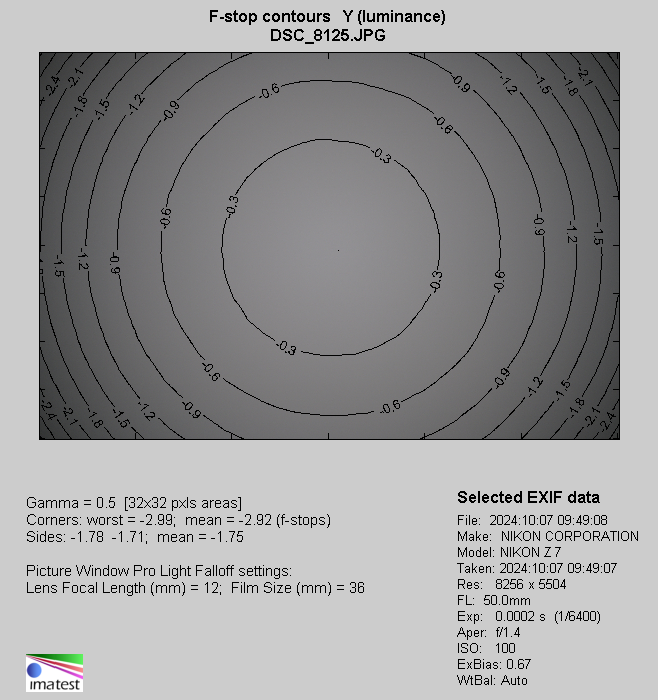Nikon Nikkor Z 50 mm f/1.4
8. Vignetting
| Z7, APS-C/DX, f/1.4 | Z7, APS-C/DX, f/2.0 |

|

|
At the maximum relative aperture vignetting is noticeable because it reaches 29% (−1.00 EV). Fortunately it is not an especially high level. By f/2.0 and f/2.8 this aberration decreases to a negligible level of, respectively, 14% (−0.43 EV) and 7% (−0.20 EV).
Please Support UsIf you enjoy our reviews and articles, and you want us to continue our work please, support our website by donating through PayPal. The funds are going to be used for paying our editorial team, renting servers, and equipping our testing studio; only that way we will be able to continue providing you interesting content for free. |
- - - - - - - - - - - - - - - - - - - - - - - - - - - - - - - - - - - - - - - - - - - - - - - -
After passing to a bigger full frame sensor vignetting becomes far more pronounced and photos below show it very clearly.
| Z7, FF, f/1.4 | Z7, FF, f/2.0 |

|

|
| Z7, FF, f/2.8 | Z7, FF, f/4.0 |

|

|
The loss if light in frame corners at the maximum relative aperture reaches as much as 64% (−2.92 EV). It's a lot but the Nikkor with its moderate dimensions doesn't fare here that bad, especially when compared to its bigger rivals. After all the Samyang AF 50 mm f/1.4 FE II showed a level of 60%, the Sony FE 50 mm f/1.4 GM had a result of 63%, and the Sigma A 50 mm f/1.4 DG DN – a loss of 67%. You have to admit that the smaller Nikkor fares quite well in comparison..
On stopping down the aperture to f/2.0 vignetting decreases to 46%(−1.76 EV), and by f/2.8 it becomes even lower descending to 38% (−1.37 EV). Another slight decrease you can observe by f/4.0, where it reaches 33% (−1.16 EV) and by f/5.6, where we got a result of 27% (−0.93 EV). By f/8.0 and f/11.0 apertures vignetting reaches, respectively 22% (−0.73 EV) and 17% (−0.55 EV).
| Nikon Z7, JPEG, 50 mm, f/1.4 |
 |






